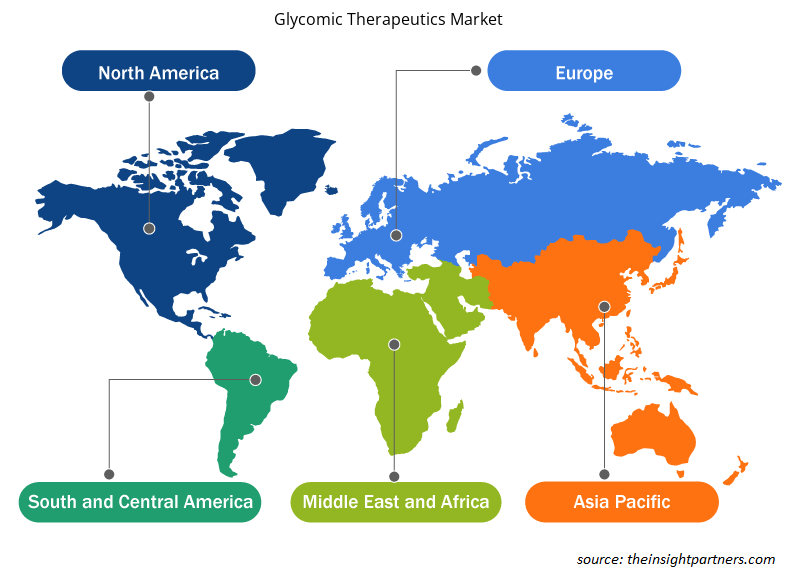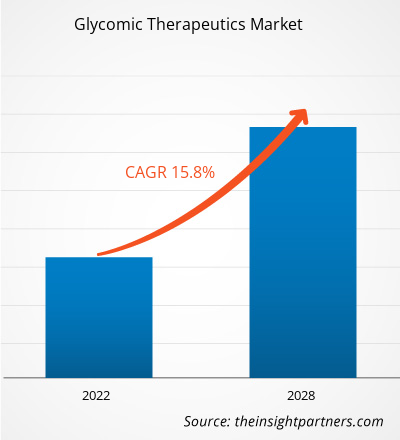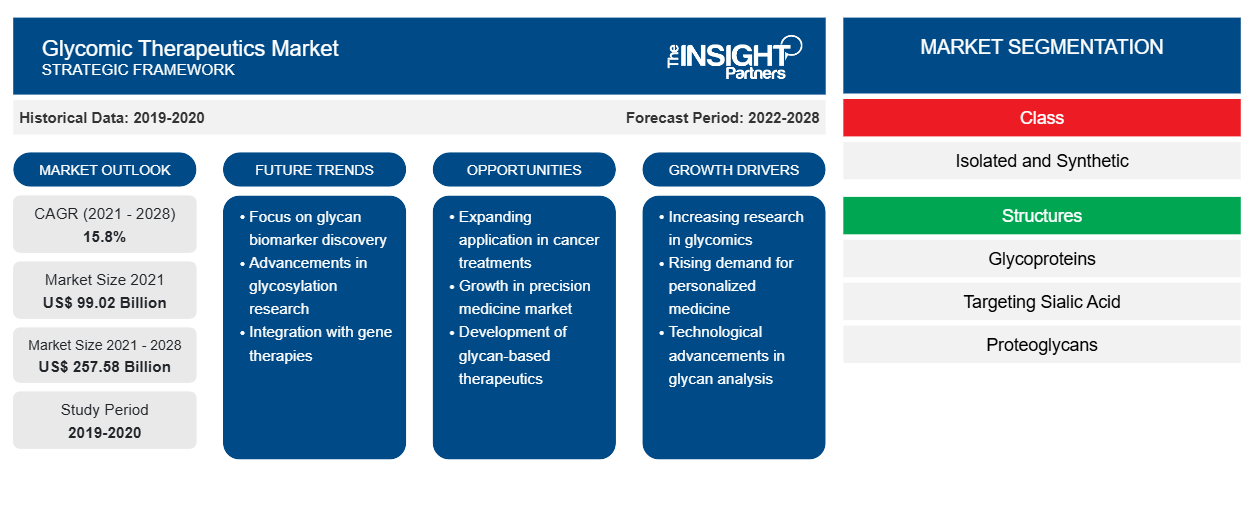Si prevede che il mercato della terapia glicomica crescerà da 99.021,46 milioni di dollari nel 2021 a 257.578,79 milioni di dollari nel 2028; si stima che crescerà con un CAGR del 15,8% dal 2022 al 2028.
Il rapporto evidenzia le tendenze prevalenti e i fattori che guidano la crescita del mercato. La glicomica si concentra sulle strutture e sulle funzioni dei carboidrati complessi, come quelli presenti nelle glicoproteine, nei glicolipidi e nei glicosamminoglicani. I glicani sono responsabili di gran parte della variazione strutturale nei sistemi biologici e la loro rappresentazione sulle superfici cellulari è comunemente chiamata "glicoma". Questi glicani sono presenti in molte aree del microbioma, tra cui superfici cellulari e proteine, e possono essere incredibilmente complessi. La glicomica microbica è pronta a rivoluzionare la diagnosi delle malattie, la rilevazione del cancro, la medicina personalizzata, il vaccino antimicrobico e la scoperta di farmaci. Come agenti terapeutici, i nanomateriali integrati in glicani possono essere utilizzati come vaccino contro infezioni virali e batteriche e cellule tumorali.
Il rapporto offre approfondimenti e analisi approfondite del mercato globale della terapia glicomica , sottolineando vari parametri, tra cui tendenze di mercato, progressi tecnologici, dinamiche di mercato e analisi del panorama competitivo dei principali attori del mercato globale. Include anche l'impatto della pandemia di COVID-19 sul mercato in tutte le regioni. L'impatto complessivo della pandemia di COVID-19 sul mercato della terapia glicomica è stato misto; quindi, il mercato sta ancora guadagnando terreno e si prevede che crescerà nei prossimi anni. I sistemi sanitari sono stati sovraccarichi e la fornitura di assistenza medica a tutti i pazienti è diventata una sfida. Inoltre, l'industria biotecnologica ha dovuto affrontare l'impatto indesiderato della pandemia. Durante la pandemia di COVID-19, le aziende di dispositivi medici hanno riscontrato difficoltà nella gestione delle proprie attività. Molte aziende di terapia glicomica avevano le proprie attività commerciali negli Stati Uniti e la pandemia ha gravemente colpito diverse attività. Tuttavia, dopo che le restrizioni pandemiche si sono normalizzate, il volume delle procedure chirurgiche è tornato a livelli normali. Gli ospedali hanno gradualmente ripreso le procedure elettive poiché il tasso di recupero da COVID-19 stava aumentando. È aumentata anche la domanda di farmaci a base di glicani per applicazioni terapeutiche e di sviluppo di vaccini.
Personalizza questo report in base alle tue esigenze
Riceverai la personalizzazione gratuita di qualsiasi report, comprese parti di questo report, o analisi a livello nazionale, pacchetto dati Excel, oltre a usufruire di grandi offerte e sconti per start-up e università
-
Scopri le principali tendenze di mercato in questo rapporto.Questo campione GRATUITO includerà analisi di dati che spaziano dalle tendenze di mercato alle stime e alle previsioni.
Approfondimenti basati sulla geografia
In base alla geografia, il mercato globale della terapia glicomica è segmentato in Nord America (Stati Uniti, Canada e Messico), Europa (Regno Unito, Germania, Francia, Italia, Spagna e resto d'Europa), Asia Pacifico (Cina, Giappone, India, Australia, Corea del Sud e resto dell'Asia Pacifico), Medio Oriente e Africa (Emirati Arabi Uniti, Arabia Saudita, Sudafrica e resto del Medio Oriente e dell'Africa) e Sud e Centro America (Brasile, Argentina e resto del Sud e Centro America).
Approfondimenti di mercato
Aumento della ricerca e dello sviluppo nel campo della terapia glicomica
I glicani sono estremamente complessi e si trovano in molte aree dei componenti del microbioma, come proteine e superfici cellulari. I ricercatori e gli operatori sono attivamente coinvolti nel settore della glicomica e si concentrano costantemente sugli sviluppi tecnologici per offrire alternative migliori alle tecniche convenzionali. Di seguito sono riportati alcuni esempi di ricerca e sviluppo nel mercato della terapia glicomica:
- Nel febbraio 2022, la National Science Foundation (NSF) ha assegnato circa 23 milioni di dollari USA a una nuova partnership multi-universitaria, guidata congiuntamente da Virginia Tech e University of Georgia, 2020, per accelerare la ricerca sui glicomateriali negli Stati Uniti. Questa partnership ha riunito i migliori scienziati e ingegneri di queste istituzioni, insieme alla Brandeis University, al Rensselaer Polytechnic Institute e alla University of North Carolina a Chapel Hill, per istituire un centro nazionale di ricerca sui glicomateriali.
- A marzo 2022, Palleon Pharmaceuticals, un'azienda pioniera nel campo dell'immunologia del glicole per il trattamento del cancro e delle malattie infiammatorie, ha annunciato il dosaggio del primo paziente nello studio di fase 1/2 dell'azienda su E-602 in pazienti affetti da tumori avanzati. Lo studio, denominato GLIMMER-01 (Glycan-Immune Regulation), è il primo studio clinico del nuovo approccio di Palleon all'immunoterapia del cancro, che ha come target i sialoglicani immunosoppressori.
- Nell'aprile 2022, i ricercatori di glicoproteomica del CPTAC hanno sviluppato il metodo di identificazione multiattributo dei glicani "Peptide-First".
- Nel marzo 2022, i ricercatori giapponesi hanno scoperto il meccanismo preciso di un enzima associato al beta-1,2-glucano per fornire nuove informazioni sul metabolismo complicato degli zuccheri. Un team di ricercatori della Niigata University e della Tokyo University of Science ha identificato la struttura e la funzione di un nuovo enzima con attività glicosiltransferasi. I risultati di questa indagine sono stati resi pubblici il 19 gennaio 2022 e sono stati stampati sul Journal of Biological Chemistry, Volume 298, Numero 3.
- Secondo uno studio pubblicato nel febbraio 2022 dai ricercatori del Centro di glicomica dell'Università di Copenaghen, l'eparina può ora essere prodotta senza l'impiego di animali attraverso studi di glicomica.
- A febbraio 2022, GlycoMIP, un polo di ricerca nazionale incentrato sulla ricerca sui glicomateriali e guidato congiuntamente da Virginia Tech e University of Georgia, ha celebrato la grande inaugurazione della sua struttura nazionale per gli utenti con cerimonie di taglio del nastro in entrambe le università. GlycoMIP affronterà i colli di bottiglia a livello nazionale nella sintesi dei glicomateriali, nella modellazione al computer, nella caratterizzazione dei materiali e nella condivisione delle conoscenze attraverso una ricerca innovativa e una struttura nazionale per gli utenti unica che fornirà strumenti e servizi essenziali alla comunità scientifica.
Tali progressi nel campo della glicomica stimolano in modo significativo la crescita del mercato delle terapie glicomiche.
Approfondimenti basati sulla classe
In base alla classe, il mercato della terapia glicomica è diviso in isolato e sintetico. Nel 2021, il segmento sintetico ha rappresentato una quota di mercato maggiore. Tuttavia, si prevede che il segmento isolato registrerà un CAGR più elevato del 16,3% durante il periodo di previsione.
Approfondimenti basati sulla struttura
In base alle strutture, il mercato della terapia glicomica è segmentato in glicoproteine, che prendono di mira l'acido sialico, proteoglicani, che prendono di mira i glicosamminoglicani, proteine ancorate al glicofosfatidilinositolo (GPI) e glicani a base di eparina, che prendono di mira i glicosfingolipidi e altri. Il segmento delle glicoproteine ha detenuto la quota di mercato maggiore nel 2021. Tuttavia, si prevede che il segmento che prende di mira l'acido sialico registrerà il CAGR più elevato durante il periodo di previsione.
Approfondimenti basati sulle indicazioni
In base all'indicazione, il mercato della terapia glicomica è segmentato in trombosi e chemioprofilassi, anemia, anti-adesivi e antinfiammatori, cataratta, malattie di Gaucher , MPS-1 e IV, cancro, malattia di Alzheimer, influenza di tipo A e B e altri. Il segmento dell'influenza di tipo A e B ha detenuto la quota di mercato maggiore nel 2021 e si prevede che continuerà un trend simile durante il periodo di previsione.
Approfondimenti regionali sul mercato terapeutico glicomico
Le tendenze regionali e i fattori che influenzano il mercato Glycomic Therapeutics durante il periodo di previsione sono stati ampiamente spiegati dagli analisti di Insight Partners. Questa sezione discute anche i segmenti e la geografia del mercato Glycomic Therapeutics in Nord America, Europa, Asia Pacifico, Medio Oriente e Africa e Sud e Centro America.

- Ottieni i dati specifici regionali per il mercato Glycomic Therapeutics
Ambito del rapporto di mercato di Glycomic Therapeutics
| Attributo del report | Dettagli |
|---|---|
| Dimensioni del mercato nel 2021 | 99,02 miliardi di dollari USA |
| Dimensioni del mercato entro il 2028 | 257,58 miliardi di dollari USA |
| CAGR globale (2021 - 2028) | 15,8% |
| Dati storici | 2019-2020 |
| Periodo di previsione | 2022-2028 |
| Segmenti coperti |
Per classe
|
| Regioni e Paesi coperti |
America del Nord
|
| Leader di mercato e profili aziendali chiave |
|
Densità dei player del mercato della terapia glicomica: comprendere il suo impatto sulle dinamiche aziendali
Il mercato Glycomic Therapeutics Market sta crescendo rapidamente, spinto dalla crescente domanda degli utenti finali dovuta a fattori quali l'evoluzione delle preferenze dei consumatori, i progressi tecnologici e una maggiore consapevolezza dei benefici del prodotto. Con l'aumento della domanda, le aziende stanno ampliando le loro offerte, innovando per soddisfare le esigenze dei consumatori e capitalizzando sulle tendenze emergenti, il che alimenta ulteriormente la crescita del mercato.
La densità degli operatori di mercato si riferisce alla distribuzione di aziende o società che operano in un particolare mercato o settore. Indica quanti concorrenti (operatori di mercato) sono presenti in un dato spazio di mercato in relazione alle sue dimensioni o al valore di mercato totale.
Le principali aziende che operano nel mercato della terapia glicomica sono:
- Intellihep Ltd
- Bioterapeutica Protalix
- Azienda farmaceutica BioMarin Inc.
- Genzyme Corporation (Sanofi)
- Azienda produttrice di Halozyme Therapeutics, Inc.
Disclaimer : le aziende elencate sopra non sono classificate secondo un ordine particolare.

- Ottieni una panoramica dei principali attori del mercato Glycomic Therapeutics
Modalità di approfondimenti basati sull'azione
In base alla modalità di azione, il mercato della terapia glicomica è segmentato in inibitori della neuraminidasi; inibitori dell'eparanasi e delle selectine e blocca le interazioni tra i fattori di crescita e l'eparan solfato; eritropoietina e terapia enzimatica sostitutiva (ERT) ; attivatore tissutale del plasminogeno; inibitori della glucosilceramide sintasi; interleuchina 1, 2 e 3; interferoni beta e gamma; e altri. Nel 2021, il segmento dell'eritropoietina e della terapia enzimatica sostitutiva (ERT) ha detenuto la quota maggiore del mercato. Tuttavia, si prevede che il segmento degli inibitori della neuraminidasi registrerà il CAGR più elevato durante il periodo di previsione.
Intellihep Ltd; Protalix Biotherapeutics; BioMarin Pharmaceutical Inc.; Genzyme Corporation (Sanofi); Halozyme Therapeutics, Inc.; Bayer AG; Alzheon, Inc.; GlycoMar; GlaxoSmithKline plc.; e F. Hoffmann-La Roche Ltd sono tra i principali attori che operano nel mercato della terapia glicomica. Queste aziende hanno implementato varie strategie che hanno contribuito alla loro crescita, determinando diversi sviluppi nel mercato.
- Analisi storica (2 anni), anno base, previsione (7 anni) con CAGR
- Analisi PEST e SWOT
- Valore/volume delle dimensioni del mercato - Globale, Regionale, Nazionale
- Industria e panorama competitivo
- Set di dati Excel
Report recenti
Testimonianze
Motivo dell'acquisto
- Processo decisionale informato
- Comprensione delle dinamiche di mercato
- Analisi competitiva
- Analisi dei clienti
- Previsioni di mercato
- Mitigazione del rischio
- Pianificazione strategica
- Giustificazione degli investimenti
- Identificazione dei mercati emergenti
- Miglioramento delle strategie di marketing
- Aumento dell'efficienza operativa
- Allineamento alle tendenze normative























 Ottieni un campione gratuito per - Mercato della terapia glicomica
Ottieni un campione gratuito per - Mercato della terapia glicomica